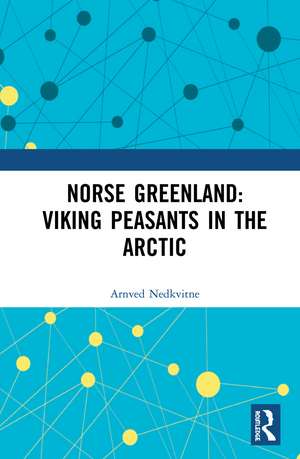Norse Greenland: Viking Peasants in the Arctic
Autor Arnved Nedkvitneen Limba Engleză Paperback – 30 iun 2020
Norse Greenland was the stepping stone for the Europeans who first discovered America and settled briefly in Newfoundland ca. AD 1000. The community had a global significance which surpassed its modest size.
In the last decades scholars have been nearly unanimous in emphasising that long-term climatic and environmental changes created a situation where Norse agriculture was no longer sustainable and the community was ruined. A secondary hypothesis has focused on ethnic confrontations between Norse peasants and Inuit hunters. In the last decades ethnic violence has been on the rise in Eastern Europe, the Middle East and parts of Africa. In some cases it has degenerated into ethnic cleansing. This has strengthened the interest in ethnic violence in past societies. Challenging traditional hypotheses is a source of progress in all science. The present book does this on the basis of relevant written and archaeological material respecting the methodology of both sciences.
Preț: 397.12 lei
Nou
Puncte Express: 596
Preț estimativ în valută:
75.100€ • 82.52$ • 63.84£
75.100€ • 82.52$ • 63.84£
Carte tipărită la comandă
Livrare economică 22 aprilie-06 mai
Preluare comenzi: 021 569.72.76
Specificații
ISBN-13: 9780367585808
ISBN-10: 0367585804
Pagini: 446
Dimensiuni: 156 x 234 x 30 mm
Greutate: 0.64 kg
Ediția:1
Editura: Taylor & Francis
Colecția Routledge
Locul publicării:Oxford, United Kingdom
ISBN-10: 0367585804
Pagini: 446
Dimensiuni: 156 x 234 x 30 mm
Greutate: 0.64 kg
Ediția:1
Editura: Taylor & Francis
Colecția Routledge
Locul publicării:Oxford, United Kingdom
Public țintă
PostgraduateNotă biografică
Arnved Nedkvitne is Professor Emeritus of Medieval History from the universities of Trondheim and Oslo. His main field of study has been pre-modern Norwegian social and economic organisation. Relevant monographs include: The Peasant Economy of the Atlantic and North Sea Coast of Norway 1500–1730 (Oslo 1988, translation of the Norwegian title), Lay Belief in Norse Society (Copenhagen 2009) and The German Hansa and Bergen 1100-1600 (Cologne 2014).
Cuprins
INTRODUCTION / 1 The problem / 2 Earlier research / 3 The contribution of this volume / CHAPTER I THE INITIAL SETTLEMENT IN AD 985/6 / 1 The Icelandic sagas as historical sources / 2 The first Greenlanders / 3 Conclusion / CHAPTER II POLITICAL ORGANISATION / 1 Ethnic identity / 2 Violence in a pre-state society / 3 Jurisdiction on pre state Greenland / 4 Financing state functions in the pre state period / 5 Ties to the Norwegian king before 1261 / 6 Attempts to organise a state administration after 1261/ CHAPTER III CHURCH AND RELIGION / 1 Christianisation / 2 Church organisation before the parish (AD 1000-1124) / 3 The parish 1124 – 1340 / 4 The Gardar diocese / 5 The monasteries / 6 The supernatural and the natural world / 7 The Greenland church in its final decades 1340-1410 / CHAPTER IV TRADE AND SHIPPING / 1 The imports / 2 The exports / 3 Quantifying trade and shipping to Norse Greenland / 4 Crossing the Greenland Ocean / 5 Overseas destinations / 6 Ships and boats / 7 The merchants / 8 The political framework for trade and shipping / CHAPTER V SUBSISTENCE FOOD PRODUCTION / 1 The basis: animal husbandry / 2 Providing fodder for domestic animals / 3 Animal husbandry in crisis? / 4 Hunting and fishing as flexible supplements / 5 The quality of the Norse Greenlanders’ diet / 6 Norse and Inuit adaptation to the Greenland environment / 7 Did the last Norsemen die from starvation or undernourishment? / CHAPTER VI ONE LAND – TWO SOCIETIES / 1 Inuit attitude to violence / 2 Norse encounters with Inuit from beginning to end / 3 We found a rich land, but are not destined to enjoy it.
Recenzii
'What happened to the Norse people? A widespread hypothesis is that climate change drove them away. But in [this] new book, the Norwegian medieval historian Arnved Nedkvitne reaches a far more bloody and inconvenient conclusion about the lost people: that it was the Inuit who moved down the coast and killed them' [translation from original Danish] - Anne Knudsen, Weekendavisen.
‘While conclusive determination of the exact cause of the ultimate demise remains elusive, the book makes a valuable large-scale contribution through the successful embedding of the Norse Greenlanders in greater Norse political, economic and social identities.’ – The Economic History Review (72: 3).
‘While conclusive determination of the exact cause of the ultimate demise remains elusive, the book makes a valuable large-scale contribution through the successful embedding of the Norse Greenlanders in greater Norse political, economic and social identities.’ – The Economic History Review (72: 3).
Descriere
Norse Greenland was the stepping stone for the Europeans who first discovered America and founded the Vinland settlement in Newfoundland. This volume is a comprehensive presentation of the community of 2000-3000 Viking peasants who lived on Arctic Greenland for over 400 years (ca. 985 - 1415). Norse agriculture in an Arctic environment met ecologic
